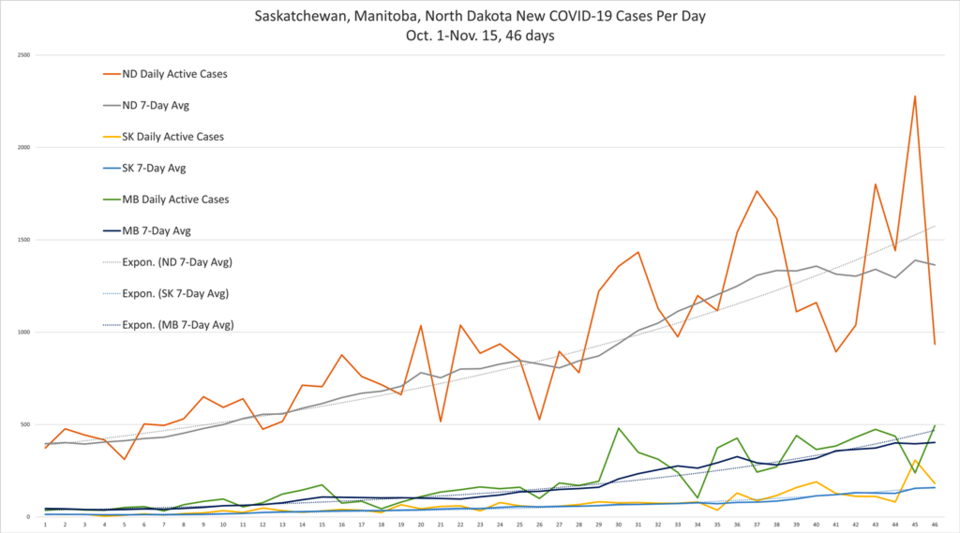Between Oct. 1 and Nov. 15, both Saskatchewan and Manitoba’s 7-day average count of new COVID-19 cases has been growing at similar exponential rates, with doubling of the numbers occurring on semi-regular intervals. Additionally, Manitoba’s COVID-related deaths, based on a rolling 7-day average, also grew at an exponential rate.
North Dakota, whose new COVID-19 case numbers are significantly higher than both Saskatchewan and Manitoba, is also seeing exponential growth, but at a lower rate, with longer intervals between doublings.
These calculations are all based on the rolling 7-day average of new COVID-19 cases announced per day, from publicly-released daily case counts and deaths from the health ministries of each jurisdiction.
In Saskatchewan, on Oct. 1 the 7-day average new case count was 13.7 cases per day. On Oct. 10, Saskatchewan exceeded 15 cases per day, with 16.3 average cases per day. Five days later, Saskatchewan’s count doubled, exceeding 30 average cases per day with a 31.4 average cases per day.
Exactly two weeks after that, the 7-day average doubled again, hitting 60 average cases per day with an average of 61.7 cases per day on Oct. 29. Twelve days after that, Saskatchewan doubled again, hitting 120.7 aver cases per day on Nov. 10. On Nov. 15, it was 158.6, in keeping with the trend established over the previous 46 days.
These numbers are significant, as they were identified by Saskatchewan Chief Medical Officer of Health Dr. Saqib Shahab during a COVID-19 update press conference in Regina on Oct. 13. He said, “Like I said in the past, five cases per 100,000, which is about 60 cases per day, is when we need to sit up and start taking notice. But then, 10 cases per 100,000, which is around 120 cases per day, on average, is when we need to start looking at specific measures to slow our transmission rate down.”
The 60 cases per day to five cases per 100,000 ratio doesn’t equate exactly to either Manitoba, which has 1.38 million people, or North Dakota, which has 762,000. But the growth rates are applicable.
The mathematical equation for Saskatchewan’s growth from Oct. 1 to Nov. 15 is y = 13.7e0.0532x, where the start point was 13.7 average cases per day and the growth rate is 0.0532.
Manitoba
You have to reach back to Sept. 24 to find when Manitoba’s 7-day average case count hit 30, with a number of 31 on that day. It took Manitoba 16 days to hit an average of 60 average cases per day, on Oct. 10, with a number of 60.3. Fifteen days later, Manitoba doubled again, hitting 135.4 average cases per day, exceeding the 120 average cases per day for the first time. And then Manitoba accelerated greatly, taking only seven additional days to double one more time, exceeding 240 average cases per day on Nov. 1, with an average of 255.4 average cases per day. By Nov. 15, the average was 403.4 cases per day, close to on track for hitting 480 per day, another doubling, in the coming days if that growth rate continues.
The mathematical equation for Manitoba’s growth is y = 45.5e0.0475x , where the start point on Oct. 1 was 45.4 average cases per day, with a growth rate of 0.0475, slightly below Saskatchewan’s 0.0532.
As such, Saskatchewan is roughly 17 to 18 days behind Manitoba. Manitoba hit 60 average cases per day on Oct. 10. Saskatchewan did the same on Oct. 29, 19 days later. Manitoba hit 120 average cases per day on Oct. 25. Saskatchewan dis so on Nov. 10, 16 days later.
This bears out in the actual numbers, as Saskatchewan’s most recent numbers – with 181 active cases on Nov. 15 and 308 the day before, show a 7-day average of 158.6 cases. Manitoba hit that level on Oct. 29, with 160.4 cases. Thus, Saskatchewan was again 17 days behind Manitoba.
Notably, Manitoba’s death rate has also climbed at an exponential rate, doubling at increasingly shorter intervals. The province posted at least one death every day since Oct. 21. Based on the 7-day averages, Manitoba began averaging one death per day on Oct. 8. Seventeen days later, on Oct. 25, that doubled to an average of two deaths per day. Twelve days after that, on Nov. 6, the average doubled again to four deaths per day. Nine days after that, on Nov. 15, Manitoba averaged eight deaths per day.
Saskatchewan’s number of deaths has not been significant enough to show a trend line.
North Dakota
North Dakota has seen similar exponential growth, albeit at a slower rate, for most of that period.
The state had 500.1 cases per day on Oct. 10, reaching the 480 cases per day level for the first time. It took 42 days for the state to double its 240 cases per day reached on Aug. 29, when it posted a 252.1 average cases per day.
North Dakota doubled again in 21 days, hitting the 960 cases per day level on Oct. 31. It continued on an upward trajectory until Nov. 14, when the state posted an average of 1,389.1 cases per day and an actual single-day count of 2,278. However, in the two days following, with 935 and 1,089 single day case counts posted for those days, the trend started to show signs of levelling off.
The equation for North Dakota’s growth is y = 396.4e0.0269x, where the starting point is 396.4 average cases per day on Oct. 1, the end point is 1364 average cases per day on Nov. 15, and the growth rate is 0.0269, meaning that both Manitoba and Saskatchewan are currently seeing higher rates of growth than North Dakota.



